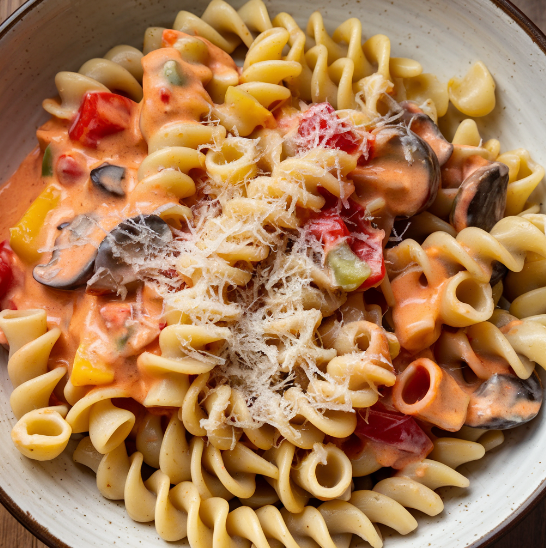Is Cavatappi the Same as Elbow Macaroni? Exploring Their Differences, Uses, and Best Dishes
When it comes to pasta, many shapes and sizes are available. But when you’re looking at cavatappi and elbow macaroni, the question arises: Is cavatappi the same as elbow macaroni? While these two types of pasta may look somewhat similar at first glance, they are different in several key ways. In this article, we’ll explore the differences between these pasta types, when to use them, and the dishes that suit each one best. By the end, you’ll know exactly when to choose cavatappi or elbow macaroni for your next meal.
H2: What Is Cavatappi?
Cavatappi, often called “corkscrew pasta,” is a ridged, spiral-shaped pasta. Its name comes from the Italian word for corkscrew, which perfectly describes its twisted form. This shape makes it great at holding onto thick, creamy sauces. Cavatappi’s spirals and ridges make it the go-to pasta for rich dishes where you want every bite coated with sauce.
H3: Why Cavatappi Stands Out
Cavatappi stands out because of its spiral shape and ridged texture. Unlike other pasta types, which might let sauces slip off, cavatappi’s curves hold on to every drop of sauce. Whether you’re making mac and cheese or a baked pasta dish, this pasta ensures you get the maximum flavor in every bite. Its size and shape also make it an ideal choice for baked dishes where the pasta needs to stand up to extended cooking times and heavier ingredients.
H2: What Is Elbow Macaroni?
Elbow macaroni is a much smaller pasta, commonly used in comfort dishes like macaroni and cheese. It gets its name from its characteristic small, curved shape that looks like a bent elbow. Elbow macaroni is a staple in many households because it’s versatile, quick to cook, and easy to incorporate into different types of dishes.
H3: When to Use Elbow Macaroni
Elbow macaroni is best for lighter, quicker dishes. Its small size allows it to cook faster than many other types of pasta, which is why it’s often used in quick weeknight dinners. Macaroni and cheese, pasta salads, and casseroles are all excellent choices for this pasta. It’s especially good when you need a pasta that blends seamlessly with other ingredients, rather than standing out on its own like cavatappi.
H2: The Differences Between Cavatappi and Elbow Macaroni
So, is cavatappi the same as elbow macaroni? The answer is no. While they might be used interchangeably in some recipes, they have distinct differences in shape, size, texture, and the types of dishes they complement. Let’s break down these differences further.
- Shape: Cavatappi is spiral-shaped, while elbow macaroni has a simple, curved shape. The spiral shape of cavatappi makes it more visually interesting and better at holding onto sauces.
- Size: Cavatappi is generally larger and thicker than elbow macaroni, which is small and lightweight. This makes cavatappi more filling and substantial in dishes.
- Texture: Cavatappi has ridges along the outside, which help it cling to thick sauces. Elbow macaroni, while smooth, is still versatile, but it doesn’t hold onto sauces as well.
- Cooking Time: Because of its larger size, cavatappi usually takes a bit longer to cook compared to elbow macaroni. If you’re in a hurry, elbow macaroni is often the quicker option.
H3: Which Pasta Holds Sauce Better?
The design of cavatappi makes it superior when it comes to holding onto sauces. The ridges and spirals create more surface area for the sauce to cling to, making it ideal for dishes with creamy or thick sauces like Alfredo or cheese-based sauces. Elbow macaroni, while great for thinner sauces, doesn’t hold onto the sauce as well due to its smoother texture.
H2: Can You Substitute Cavatappi for Elbow Macaroni?
Yes, you can substitute cavatappi for elbow macaroni in most recipes, but the final dish may have a slightly different texture and appearance. If you’re making a dish like macaroni and cheese, substituting cavatappi will result in a heartier dish with more sauce coverage. In pasta salads, however, elbow macaroni may be a better choice due to its smaller size, which blends more seamlessly with other ingredients.
H3: Substitution Tips
If you’re thinking of substituting one for the other, consider the following:
- In creamy dishes: Cavatappi works better as a substitute because it holds onto sauce more effectively.
- In pasta salads: Elbow macaroni is better for cold dishes because of its smaller size and smooth texture.
- In baked dishes: Both can work, but cavatappi will give a more substantial bite.
H2: The Best Dishes for Cavatappi and Elbow Macaroni
Now that we’ve explored the differences between cavatappi and elbow macaroni, let’s look at the best dishes for each pasta.
- Cavatappi: Cavatappi shines in baked pasta dishes, rich mac and cheese, or casseroles that require a pasta that can stand up to heavy sauces and cheeses. It’s also a great choice for pasta dishes that include larger pieces of vegetables or meats because its larger size provides a balance.
- Elbow Macaroni: Elbow macaroni is perfect for classic macaroni and cheese, lighter pasta salads, or as a base for quick one-pot meals. Its small size and quick cooking time make it ideal for weeknight dinners when you need something fast and delicious.
H2: Health Benefits and Nutritional Differences
When it comes to nutrition, cavatappi and elbow macaroni are quite similar. Both are typically made from the same ingredients: semolina flour and water. The nutritional differences come down to serving size, as cavatappi’s larger shape may result in larger portion sizes when compared to elbow macaroni. Here’s a quick comparison of typical nutritional content for a standard serving of each:
- Cavatappi (per serving): Approximately 200-220 calories, 40 grams of carbohydrates, 7 grams of protein, and 1 gram of fat.
- Elbow Macaroni (per serving): Approximately 180-200 calories, 38 grams of carbohydrates, 6 grams of protein, and 1 gram of fat.
H3: Whole Wheat and Gluten-Free Options
Both cavatappi and elbow macaroni come in whole wheat and gluten-free varieties, offering healthier options for those with dietary restrictions. Whole wheat versions are higher in fiber, while gluten-free versions cater to those with gluten sensitivities or celiac disease.
Conclusion
So, is cavatappi the same as elbow macaroni? In short, no. While they may both be used in similar dishes, their differences in shape, size, and texture make them distinct. Cavatappi’s spiral shape and ridged texture make it perfect for creamy, sauce-heavy dishes, while elbow macaroni is a great choice for lighter dishes like pasta salads or classic macaroni and cheese. The next time you’re at the grocery store, you’ll know exactly which pasta to pick for your meal. Whether you prefer the heartiness of cavatappi or the simplicity of elbow macaroni, both are sure to elevate your pasta dishes.

